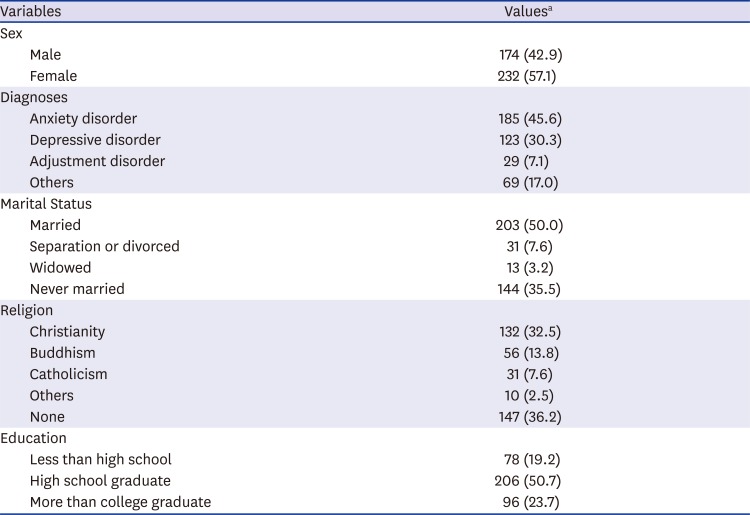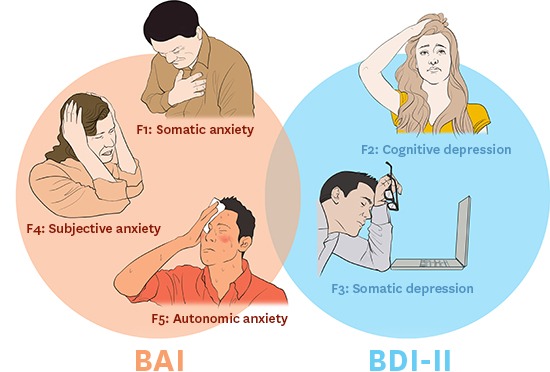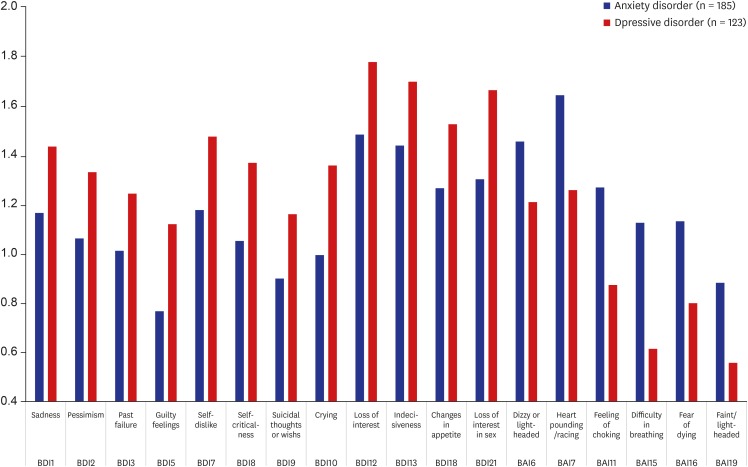1. Mineka S, Watson D, Clark LA. Comorbidity of anxiety and unipolar mood disorders. Annu Rev Psychol. 1998; 49(1):377–412. PMID:
9496627.
2. Kessler RC, Chiu WT, Demler O, Merikangas KR, Walters EE. Prevalence, severity, and comorbidity of 12-month DSM-IV disorders in the National Comorbidity Survey Replication. Arch Gen Psychiatry. 2005; 62(6):617–627. PMID:
15939839.
3. Lamers F, van Oppen P, Comijs HC, Smit JH, Spinhoven P, van Balkom AJ, et al. Comorbidity patterns of anxiety and depressive disorders in a large cohort study: the Netherlands Study of Depression and Anxiety (NESDA). J Clin Psychiatry. 2011; 72(3):341–348. PMID:
21294994.
4. Kessler RC, Nelson CB, McGonagle KA, Liu J, Swartz M, Blazer DG. Comorbidity of DSM-III-R major depressive disorder in the general population: results from the US National Comorbidity Survey. Br J Psychiatry. 1996; (30):17–30.
5. Brown TA, Campbell LA, Lehman CL, Grisham JR, Mancill RB. Current and lifetime comorbidity of the DSM-IV anxiety and mood disorders in a large clinical sample. J Abnorm Psychol. 2001; 110(4):585–599. PMID:
11727948.
6. Moras K, Clark LA, Kanton W, Roy-Bryne R, Watson D, Barlow D. Mixed anxiety-depression. In : Widiger TA, Frances AJ, Pincus HA, Ross R, First MB, editors. DSM-IV Sourcebook. Washington, D.C.: American Psychiatric Association;1996. p. 623–643.
7. American Psychiatric Association. Diagnostic and Statistical Manual of Mental Disorders: DSM-5. 5th ed. Arlington, VA: American Psychiatric Association;2013.
8. World Health Organization. The ICD-10 Classification of Mental and Behavioural Disorders: Clinical Descriptions and Diagnostic Guidelines. Geneva, Switzerland: World Health Organization;1992.
9. Clark LA, Watson D. Theoretical and emprical issues in differentiating depression from anxiety. In : Becker J, Kleinman A, editors. Psychosocical Aspects of Depression. Hillsdael, NJ: Erlbaum;1991. p. 39–65.
10. Feldman LA. Distinguishing depression and anxiety in self-report: evidence from confirmatory factor analysis on nonclinical and clinical samples. J Consult Clin Psychol. 1993; 61(4):631–638. PMID:
8370858.
11. Hewitt PL, Norton GR. The Beck Anxiety Inventory: a psychometric analysis. Psychol Assess. 1993; 5(4):408–412.
12. Clark LA, Watson D. Tripartite model of anxiety and depression: psychometric evidence and taxonomic implications. J Abnorm Psychol. 1991; 100(3):316–336. PMID:
1918611.
13. Clark DA, Steer RA, Beck AT. Common and specific dimensions of self-reported anxiety and depression: implications for the cognitive and tripartite models. J Abnorm Psychol. 1994; 103(4):645–654. PMID:
7822565.
14. Steer RA, Clark DA, Beck AT, Ranieri WF. Common and specific dimensions of self-reported anxiety and depression: a replication. J Abnorm Psychol. 1995; 104(3):542–545. PMID:
7673579.
15. Steer RA, Clark DA, Beck AT, Ranieri WF. Common and specific dimensions of self-reported anxiety and depression: the BDI-II versus the BDI-IA. Behav Res Ther. 1999; 37(2):183–190. PMID:
9990749.
16. Enns MW, Cox BJ, Parker JD, Guertin JE. Confirmatory factor analysis of the Beck Anxiety and Depression Inventories in patients with major depression. J Affect Disord. 1998; 47(1-3):195–200. PMID:
9476761.
17. Chung CY, Kim D. Are anxiety and depression distinct?: exploratory factor analysis of Zung’s self-rating anxiety and depression scales. Korean J Biol Psychiatry. 2013; 20(1):21–27.
18. First MB, Spitzer RL, Gibbon M, Williams JB. Structured Clinical Interview for DSM-IV Axis I Disorders, Clinician Version (SCID-CV). Washington, D.C.: American Psychiatric Press;1996.
19. Beck AT, Epstein N, Brown G, Steer RA. An inventory for measuring clinical anxiety: psychometric properties. J Consult Clin Psychol. 1988; 56(6):893–897. PMID:
3204199.
20. Yook SP, Kim ZS. A clinical study on the Korean version of Beck Anxiety Inventory: comparative study of patient and non-patient. Korean J Clin Psychol. 1997; 16(1):185–197.
21. Beck AT, Ward CH, Mendelson M, Mock J, Erbaugh J. An inventory for measuring depression. Arch Gen Psychiatry. 1961; 4(6):561–571. PMID:
13688369.
22. Beck AT, Steer RA, Brown GK. Manual for the Beck Depression Inventory-II. San Antonio, TX: Psychological Corporation;1996.
23. Kim K, Kim J, Won H. Korean Manual of Symptom Checklist-90-revision. Seoul, Korea: Jung Ang Juk Sung Publisher;1984.
25. Benjamini Y, Hochberg Y. Controlling the false discovery rate: a practical and powerful approach to multiple testing. J R Stat Soc B. 1995; 57(1):289–300.
26. Floyd FJ, Widaman KF. Factor analysis in the development and refinement of clinical assessment instruments. Psychol Assess. 1995; 7(3):286–299.
27. Beck AT, Brown G, Steer RA, Eidelson JI, Riskind JH. Differentiating anxiety and depression: a test of the cognitive content-specificity hypothesis. J Abnorm Psychol. 1987; 96(3):179–183. PMID:
3680754.
28. Yang H, Kim D, Jang EY, Park SC, Park YC. Depressive symptoms in anxiety disorder and major depressive disorder. J Korean Neuropsychiatr Assoc. 2011; 50(4):297–304.
29. Dobson KS. The relationship between anxiety and depression. Clin Psychol Rev. 1985; 5(4):307–324.
30. Brown TA, Barlow DH. Comorbidity among anxiety disorders: implications for treatment and DSM-IV. J Consult Clin Psychol. 1992; 60(6):835–844. PMID:
1460147.
31. Wetzler S, Katz MM. Problems with the differentiation of anxiety and depression. J Psychiatr Res. 1989; 23(1):1–12. PMID:
2666646.
32. Choi MK, Kim KI. Symptoms of depression in Koreans and Japanese: a cross-cultural study. Ment Health Res. 1996; 15(1):104–114.








 PDF
PDF Citation
Citation Print
Print





 XML Download
XML Download